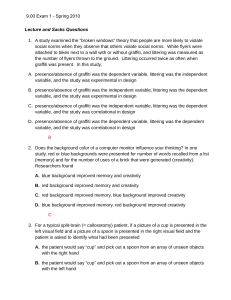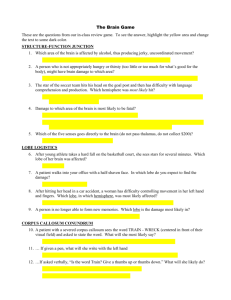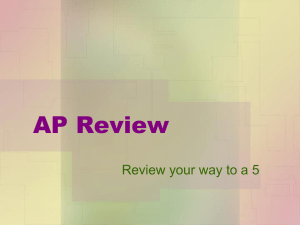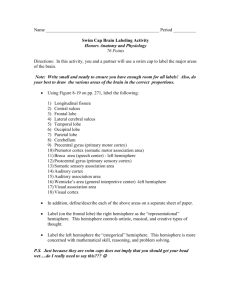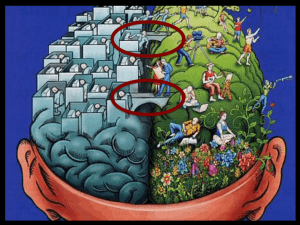9.00 Exam 1 - Spring 2010 Lecture and Sacks Questions
advertisement
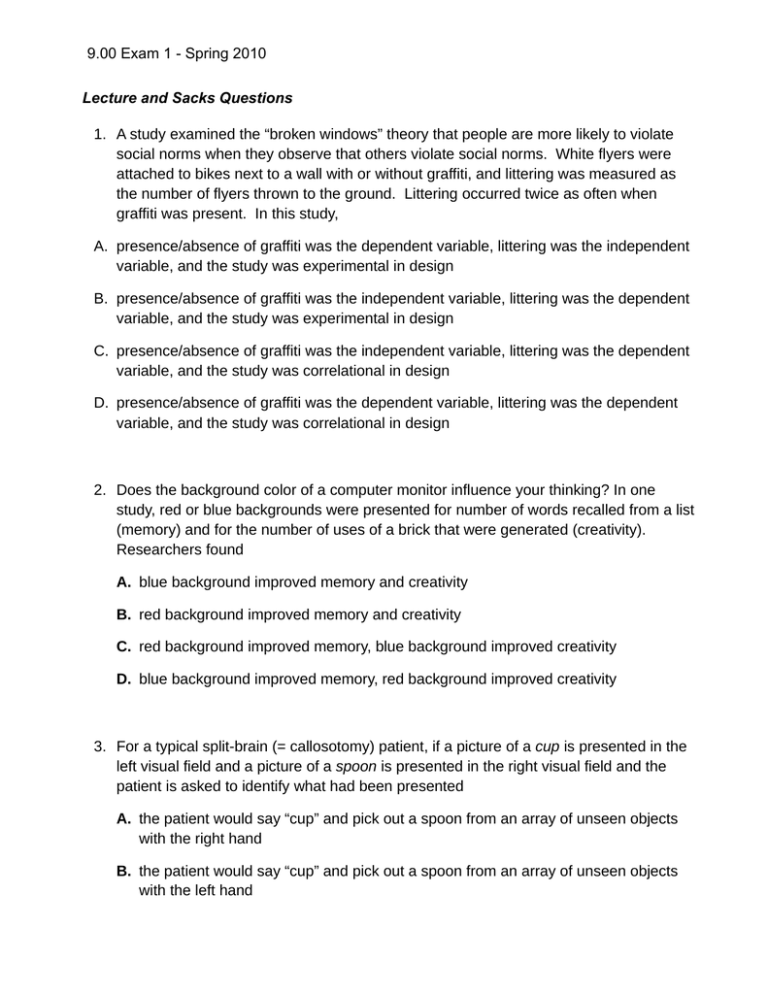
9.00 Exam 1 - Spring 2010 Lecture and Sacks Questions 1. A study examined the “broken windows” theory that people are more likely to violate social norms when they observe that others violate social norms. White flyers were attached to bikes next to a wall with or without graffiti, and littering was measured as the number of flyers thrown to the ground. Littering occurred twice as often when graffiti was present. In this study, A. presence/absence of graffiti was the dependent variable, littering was the independent variable, and the study was experimental in design B. presence/absence of graffiti was the independent variable, littering was the dependent variable, and the study was experimental in design C. presence/absence of graffiti was the independent variable, littering was the dependent variable, and the study was correlational in design D. presence/absence of graffiti was the dependent variable, littering was the dependent variable, and the study was correlational in design 2. Does the background color of a computer monitor influence your thinking? In one study, red or blue backgrounds were presented for number of words recalled from a list (memory) and for the number of uses of a brick that were generated (creativity). Researchers found A. blue background improved memory and creativity B. red background improved memory and creativity C. red background improved memory, blue background improved creativity D. blue background improved memory, red background improved creativity 3. For a typical split-brain (= callosotomy) patient, if a picture of a cup is presented in the left visual field and a picture of a spoon is presented in the right visual field and the patient is asked to identify what had been presented A. the patient would say “cup” and pick out a spoon from an array of unseen objects with the right hand B. the patient would say “cup” and pick out a spoon from an array of unseen objects with the left hand C. the patient would say “spoon” and pick out a cup from an array of unseen objects with the left hand D. the patient would say “spoon” and pick out a cup from an array of unseen objects with the right hand 4. Evidence from split-brain patients indicates A. the right hemisphere is specialized for global features and the function of a visual stimulus B. the left hemisphere is specialized for global features and the function of a visual stimulus C. the right hemisphere is specialized for local features and the appearance of a visual stimulus D. the left hemisphere is specialized for local features and the function of a visual stimulus 5. Injury to the orbitofrontal cortex in Phineas Gage primarily altered which capacity? A. motor control B. language C. audition D. character 6. The brain accounts for 2% of body mass and _____% of the body’s oxygen consumption. A. 2% B. 20% C. 50% D. 80% 7. A patient with impaired semantic knowledge about living things (foods and animals) but intact semantic knowledge about manufactured objects (tools) often has A. intact semantic knowledge about musical instruments and intact semantic knowledge about body parts B. impaired semantic knowledge about musical instruments and impaired semantic knowledge about body parts C. intact semantic knowledge about musical instruments and impaired semantic knowledge about body parts D. impaired semantic knowledge about musical instruments and intact semantic knowledge about body parts 8. Research supports all of the following conclusions about the perception of faces EXCEPT which conclusion? A. infants (6 month and younger) prefer top-heavy visual displays B. infants (6 months and younger) have better memory for human than monkey faces C. children have better memory for faces from racial groups they see growing up than faces from other racial groups D. faces are perceived and remembered configurally rather than part-by-part 9. Injury to the human amygdala impairs recognition of what facial expression? A. fear B. sadness C. disgust D. anger 10. When shadowing a verbal passage in one ear, which of the following is noticed in the message presented to the other, unattended ear? A. the content of the message B. a change from one language to another language C. a change from a voice to a tone D. a change from normal speech to nonsense backward speech 11. In visual search, preattentive search has all but which one of the following properties? A. it guides identification of conjunctions B. it operates in parallel C. it produces subjective pop-out D. it exhibits a flat slope in relation between time and set size of the display 12. In one study of blindsight, monkeys had ablation of the left primary visual cortex and the splenium of the corpus callosum. In the first experiment, monkeys responded to a light coming on by touching the location of the light on a monitor. In the second experiment, monkeys did the same task, but also touched a specified location when they believed that no light came on (blank trials). The findings were: A. monkeys identified lights coming on in both visual fields in both experiments B. monkeys identified lights coming on only in the left visual field in both experiments C. monkeys identified lights coming on in both visual fields in the second experiment, but only in the left visual field in the first experiment D. monkeys identified lights coming on in both visual fields in the first experiment, but only in the left visual field in the second experiment 13. In an experiment with infants who were cortically blind in one visual field due to hemispherectomies, the infants saw a central target, and then a peripheral target in either the good or bad visual field. In the Competition condition, the central target remained on while the peripheral target was shown. In the Non-Competition condition, the central target disappeared when the peripheral target was shown. The infants were tested at several times as they developed. The key findings were that: A. infants seldom looked at the peripheral targets in the blind field in either the Competition or Non-Competition conditions B. infants almost always looked at the peripheral targets in the blind field in both the Competition and Non-Competition conditions C. as they developed, the infants usually looked at the peripheral targets in the blind field in the Non-Competition condition, but seldom in the Competition condition D. as they developed, the infants usually looked at the peripheral targets in the blind field in the Competition condition, but seldom in the Non-Competition condition 14. A variety of results, including results from a spatial cuing task from Posner, indicate that patients with spatial neglect due to right posterior lesions have a primary deficit in A. disengaging attention from the left field B. disengaging attention from the right field C. engaging attention in the right field D. engaging attention in the left field 15. Many studies aim to show that neglect is based on a deficit of attention, not a simple loss of perception. All of the following findings support that neglect is different than simple loss of vision EXCEPT which one finding? A. neglect occurs in imagined spatial locations B. patients with neglect fail to respond to stimuli in the half of the world opposite their injury C. patients with neglect show normal preferences for objects based on information in the neglected field D. neglect follows the 180-degrees rotation of a display into the intact hemifield 16. In conditioning, partial reinforcement (relative to constant reinforcement) leads to learning that A. occurs slower, and is more resistant to extinction B. occurs faster, and is less resistant to extinction C. occurs faster, and is more resistant to extinction D. occurs slower, and is less resistant to extinction 17. Which finding or findings below do NOT challenge the claims of behaviorism that conditioning could relate any conditioned stimulus to any conditioned response? A. evidence that rats on their own would relate nausea to taste and shock to lights and sounds B. evidence that Little Albert learned fear conditioning to animals but not wooden bocks C. evidence that people are more prepared to relate shocks to snakes than flowers D. evidence that second-order conditioning can occur 18. Sacks describes two women, Mrs. O'C and Mrs. O'M, with "musical epilepsy" in which the women experienced hearing songs due to pathology in the _____, and Donald, who could not remember killing his girlfriend while under the influence of PCP but after contusions around the _______ appeared to recover memory for the murder. A. temporal lobe; frontal lobe B. frontal lobe; parietal lobe C. parietal lobe; temporal lobe D. frontal lobe; temporal lobe 19. Sacks describes Professor P, a musician who became a prosopagnosic patient. Professor P failed to recognize all of the following, except for one. Select the one answer below describing something Professor P could recognize by sight. A. abstract shapes like a cube B. a rose C. faces of his family D. emotional expression of faces in movies 20. Sacks describes Mrs. S., who exhibits spatial neglect. What things did NOT help her overcome her neglect? A. swiveling her head to find food on her plate B. a rotating wheelchair C. developing an intellectual strategy to notice things to her left D. a video system for her make-up Book Questions 21.All of the following comparisons of groups would necessarily be made using a quasi-experimental design EXCEPT: A. men vs. women B. cancer patients vs. non-cancer patients C. individuals born in Korea vs. those born in the US D. individuals exposed to a violent film vs. those not exposed to this film 22.Reliability refers to the: a. validity of data. b. values of data. c. levels of data. d. consistency of data. 23. An experiment is said to have construct validity if: A. it produces reliable findings. B. its findings can be replicated. C. its findings are consistent across experiments. D. it measures what the investigator designed it to measure. 24._____ bias occurs when participants or items are not chosen at random but instead are selected so that an attribute is over- or under-represented. A. Response B. Reliability C. Validity D. Sampling 25. _____ occur(s) when an investigator’s beliefs lead him or her to treat participants in a way that encourages them to produce the anticipated results. A. Sampling bias B. Response bias C. Experimenter expectancy effects D. A double blind design 26.Which measure of central tendency is least affected by extreme scores? A. mean B. median C. range D. standard deviation 27.Phrenology was an early attempt at explaining how the mind arises from the brain. Phrenology was rejected when which of the following claims was shown to be false? A. The shape of the skull’s outer surface is influenced by the size of underlying brain structures. B. Most personality traits are the result of many brain regions in combination. C. Functions of the brain related to thinking and personality are located in the cerebral cortex. D. Different brain regions are specialized for different mental faculties. 28.Magnetoencephalography (MEG) is a powerful technology for brain imaging because it has good resolution both to the timing of neural events and, to a lesser extent, the location of those events in the brain. Which other brain imaging technologies also offer good temporal and spatial resolution? A. fMRI = good temporal resolution, EEG = good spatial resolution B. TMS = good spatial resolution, PET = good temporal resolution C. EEG = good temporal resolution, fMRI = good spatial resolution D. PET = good spatial resolution, CT = good temporal resolution 29.Although it is much smaller, the cerebellum has as many neurons and nearly as much surface area as the cerebrum. What sorts of disorders might you expect in a patient with cerebellar lesions? A. Trouble making coordinated movements like walking or reaching. B. Auditory hallucinations of music or voices. C. Spatial neglect of the contralateral hemisphere. D. Difficulty suppressing socially inappropriate behaviors like swearing or gambling. 30.If psychologists reported that individuals’ performance on a test of spatial reasoning is 75% heritable, which of the following is true of spatial reasoning abilities? A. If a parent has good spatial reasoning abilities, his children will have a 75% chance of having good spatial reasoning abilities, too. B. In any given person, genes contribute 75% of their spatial reasoning abilities, while the environment contributes the remaining 25%. C. 75% of the population has good spatial reasoning abilities. D. 75% of the population variability in spatial reasoning is related to genetic factors. 31.Not all behaviors are voluntary or “willful”. Motor reflexes often occur as soon as, or even before, we are aware of the stimuli that caused them. Which of the following is an example of an unconscious reflex circuit? A. Sensory neurons → Cerebellum → Motor response B. Cerebral cortex → Brain stem → Motor response C. Sensory neurons → Spinal interneurons → Motor response D. Sensory neurons → Basal ganglia → Motor response 32.How is information from the eyes mapped onto visual cortex? A. The left eye sends information exclusively to the right hemisphere; the right eye sends information exclusively to the left hemisphere. B. Both eyes send information from the right visual field to the left hemisphere and information from the left visual field to the right hemisphere. C. The left eye sends information from the left visual field to the right hemisphere and from the right visual field to the left hemisphere; while the right eye sends information from the left visual field to the left hemisphere and from the right visual field to the right hemisphere. D. Both eyes send information from the left visual field to the left hemisphere, and information from the right visual field to the right hemisphere. 33.Which is true about the organization and/or representation of visual information in primary visual cortex? A. Primary visual cortex is organized into columns of orientation-selective neurons B. The fovea and periphery map onto visual cortex in proportion to the amount of space they take up in the retina C. Neurons in primary visual cortex are NOT selective for specific attributes of visual stimuli, such as bar orientations D. The left visual hemifield is retinotopically represented in the left hemisphere. 34.Which of the following is NOT used to reconstruct a 3D world from a 2D retinal image? A.Retinal disparity B.Motion parallax C.Convergence D. Gestalt similarity 35.Attention is often described in terms of “bottom-up” and “top-down” components. In the context of visual search, _________ can be used to engage _______ while ________ engages ________. A.Conjunction search; bottom-up attention; pop-out search; top-down attention. B.Conjunction search; top-down attention; pop-out search; bottom-up attention. C.Pop-out search; top-down attention; conjunction search; vigilance. D.Pop-out search; bottom-up attention; conjunction-search; vigilance. 36._________is a rebound period in which a person cannot pay attention to a different stimulus after having just paid attention to another stimulus. A. Vigilance B. Change blindness C. Repetition blindness D. Attentional blink 37.Pheromones are a class of chemical signals used by animals to communicate via olfaction. Some studies suggest that pheromones can influence human behavior. For example, A. They may increase male interest in a woman B. They may decrease female interest in a man C. They may decrease frequency of sexual intercourse D. They may decrease male interest in women 38.The first step in sensory perception is signal transduction. In visual perception, light from the outside world is transduced by ________, which contain rhodopsin. In auditory perception, pressure is transduced in the cochlea by _______. A. B. C. D. Rods/cones; hair cells Ganglion cells; hair cells Rods/cones; tympanic membrane Ganglion cells; tympanic membrane 39.Hypnosis has several therapeutic applications, including relief of pain. One technique for pain relief is known as glove anesthesia. Which of these best represents glove anesthesia? A. The hypnotist implants a post-hypnotic suggestion linking a particular piece of clothing, often a surgical glove, to reduced pain. When the patient’s pain becomes extreme, it can be lessened simply by the act of wearing the glove. B. The hypnotist suggests that the patient’s hand is anesthetized, then asks the patient to touch the painful area with the anesthetized hand. This transfers the pain relief to the affected area. C. Hypnosis is used as part of boxing training, enabling the boxer to withstand more pain in the ring (while wearing boxing gloves) than he would otherwise be able to tolerate. D. The hypnotist wears a distinctive pair of gloves, and suggests to the patient that the gloves allow him to cure pain. Because the patient is operating under trance logic, he believes the gloves have healing properties, and is relieved of pain. 40.One commonly observed effect of drinking is alcohol myopia. Which best describes what researchers mean when they use this phrase? A. The blurring of vision caused by excessive drinking B. The tendency to find members of the appropriate sex more physically attractive than they might seem under sober conditions C. The tendency to allow superficial observations to have a disproportionate impact on behavior, without allowing time for more abstract, reflective thought. D. The overestimation of your own abilities to perform tasks requiring hand-eye coordination (e.g., driving) 41.A common effect of consuming relatively small amounts of alcohol is to make people more sociable. What drug category does alcohol fall into, and what might explain that effect? A. depressant; alcohol first inhibits our existing social inhibitions, so it works as a net dis-inhibitor B. stimulant; alcohol causes release of norepinephrine which acts as an alerting agent C. stimulant; alcohol causes release of dopamine, which causes social interaction to be more rewarding D. depressant; alcohol causes release of dopamine, which causes social interaction to be more rewarding 42.One important structure involved in the regulation of human circadian rhythms is the _________, located in close proximity to the ________. A. Frontal eye fields; optic chiasm B. Frontal eye fields; parietal lobe C. suprachiasmatic nucleus; parietal lobe D. suprachiasmatic nucleus; optic chiasm 43. Which best characterizes the proportion of sleep in a night? Which best characterizes the proportion of sleep over a lifetime? A. More REM sleep earlier in a night than later; more REM sleep in old age than in infancy B. More REM sleep later in a night than earlier; more REM sleep in infancy than old age C. More REM sleep earlier in a night than later; more REM sleep in infancy than in old age D. More REM sleep later in a night than earlier; more REM sleep in old age than infancy. 44.Which of the following is not a commonly held hypothesis explaining our need to sleep? A. We sleep in order to restore our body after a hard day. B. We sleep in order to consolidate material that we’ve learned C. We sleep because our ancestors were at risk for being eaten at night, and sleeping kept us from encounters with predators at night D. We sleep in order to secrete melatonin 45.Imagine that you flinch after seeing lightning because in previous instances the lightning is followed by thunder, which scared you. In this scenario, lightning can be interpreted as being a(n): A. unconditioned stimulus B. unconditioned response C. conditioned stimulus D. conditioned response 54.Reinforcement that is given for a response emitted after each hour and half (e.g., 10 a.m., 11:30 a.m., 1 p.m.) in 55.time is most likely to be a ________ schedule 56.A. variable ratio 57.B. variable interval 58.C. fixed interval 59.D. fixed ratio 64. Carolyn desperately wants to lose weight, but finds it so difficult to resist the temptation of snack foods. Her difficulty in losing weight probably stems from the powerful effects of ________. 65.A. shaping 66.B. discrimination 67.C. delayed reinforcement 68.D. immediate reinforcement 73. Secondary reinforcers differ from primary reinforcers in that secondary reinforcers ________. 74.A. aren't as effective 75.B. can potentially reinforce or punish behavior 76.C. do not inherently satisfy physical needs 77.D. only pertain to intangible objects or events, such as praise 82. All of the following illustrate positive punishment EXCEPT: 83.A. Receiving harsh criticism for lying to your parents. 84.B. Losing telephone privileges for breaking curfew. 85.C. Getting stung by a bee when walking barefoot outside and stepping on the bee. 86.D. Getting pepper sprayed for making a lewd comment to a stranger. 91. In which phases of classical conditioning is the conditioned stimulus presented in isolation? 92.A. extinction 93.B. acquisition 94.C. rest period 95.D. A and B Short Answer Questions (Answer 5 of the following 10 questions) 1) For each blank below, did the finding occur in: both men and women, men only, or women only? In a brain imaging study of empathy, men and women played a financial game with two partners, a fair player and an unfair player. __________ showed activation in the insula when they received pain, and also when they saw the fair player receive pain. __________ showed insula activation when the unfair player received pain. _________ showed nucleus accumbens activation when the unfair player received pain. _________ reported a stronger desire for revenge against the unfair player. 2) Name the type of validity described by each of the following: A. The design and procedure appear to assess the variables of interest. B. The measures or procedure of a study are comparable to a different valid measure or procedure. C. The measures of a study assess all aspects of a phenomenon of interest. D. The measures of the study assess variables specified by a theory 3) Please read the scenario below and answer each of the following questions. Several researchers want to study the effect of exercise on visual perception. Each decides to use a different method in their study. Researcher A assigns participants to one of two groups, exercising for 10 or 0 minutes, and then records their performance on a task designed to measure visual acuity. Researcher B decides to use the same task to measure visual acuity performance from professional athletes vs. college students who do not play a sport. Researcher C asks a sample of students from a university to report the number of hours per week they exercise, then looks at the relationship between this measure and their performance on the same visual acuity task. Name the kind of method used by each researcher: A. _______________ B. _______________ C. _______________ D. Which experimenter (A, B, or C) can make the strongest claim about whether exercise is causally responsible for a difference on the visual perception task? _______________ 4) Identify the four principal lobes of the human cerebrum shown in this image: 1_______________ 2_______________ 3_______________ 4_______________ 5) Match each of the following mental faculties and behavior to the cerebral lobe above (question 4): a. Motor planning and movement b. Primary Vision c. Primary Hearing d. Spatial processing and sense of touch. 6) a. b. c. d. appropriate In the cartoon of a neuron below: Identify the dendrites Identify the axon Indicate where neurotransmitters are released Draw an arrow indicating the direction of the action potential (the direction of information processing in the cell). 7) Name the four explanations for dreaming presented in the textbook, and provide a one-sentence explanation of each: 8) What are 3 psychological, physiological, or behavioral signatures of the following stages of sleep? (3 per sleep stage) REM: _______________ Stage1: _______________ Stage2: _______________ Stage3&4: _______________ 9) Over time, heroin users report needing more and more heroin to get the same high. This is an example of _________. When the user stops taking heroin, he/she will likely develop seriously uncomfortable side effects, known as ___________________. These are particularly bad with heroin, as heroin is in the ______ class of drugs, which bind to the same receptors that endorphins bind to. More generally, heroin is known as a ___________, which is a broader class of drugs that dulls the senses and relieves pain. (Choose a different answer for the third and fourth blank) 10) Garcia and Koelling noticed that some rats developed taste aversion to drinking water. According to them the unconditioned stimulus was _________________ and the conditioned stimulus was _______________. However, they also found that when they paired a shock with bright lights and noise and tasteless water, rats avoided the water paired with the light and noise but not the water that had a sweet taste. They could only get the rats to avoid the sweet tasting water when they were given radiation. This indicates that taste aversion could be conditioned to a _______________ stimulus, but not to a _____________ stimulus. 11) Shocking a rat or giving a student a bad grade is an example of ________________. Not allowing a child to watch TV after getting a bad grade is an example of ________________. The child then comes home from school with a good grade and the parent gives the child a cookie. This is an example of _______________. Negative reinforcement occurs when _________________. MIT OpenCourseWare http://ocw.mit.edu 9.00SC Introduction to Psychology Fall 2011 For information about citing these materials or our Terms of Use, visit: http://ocw.mit.edu/terms.
